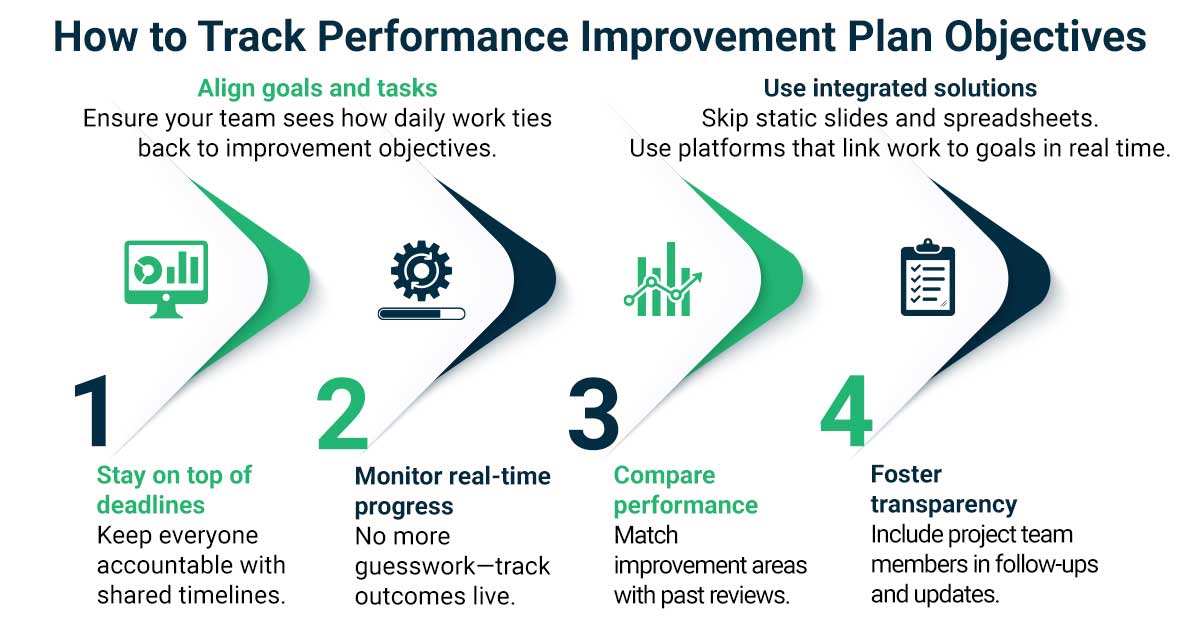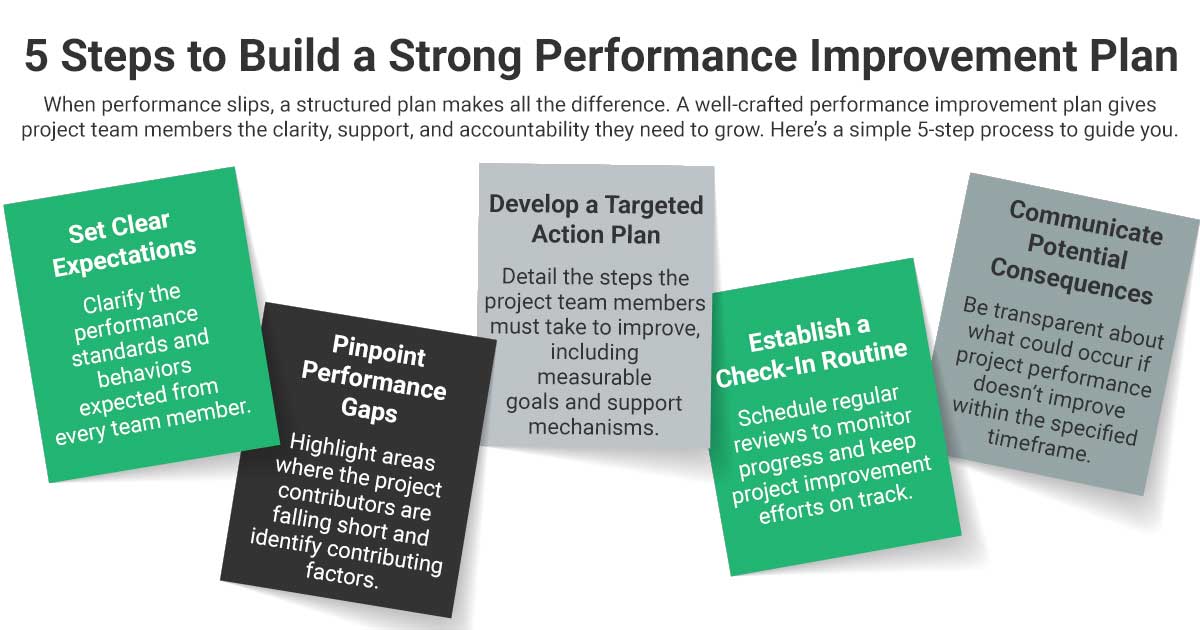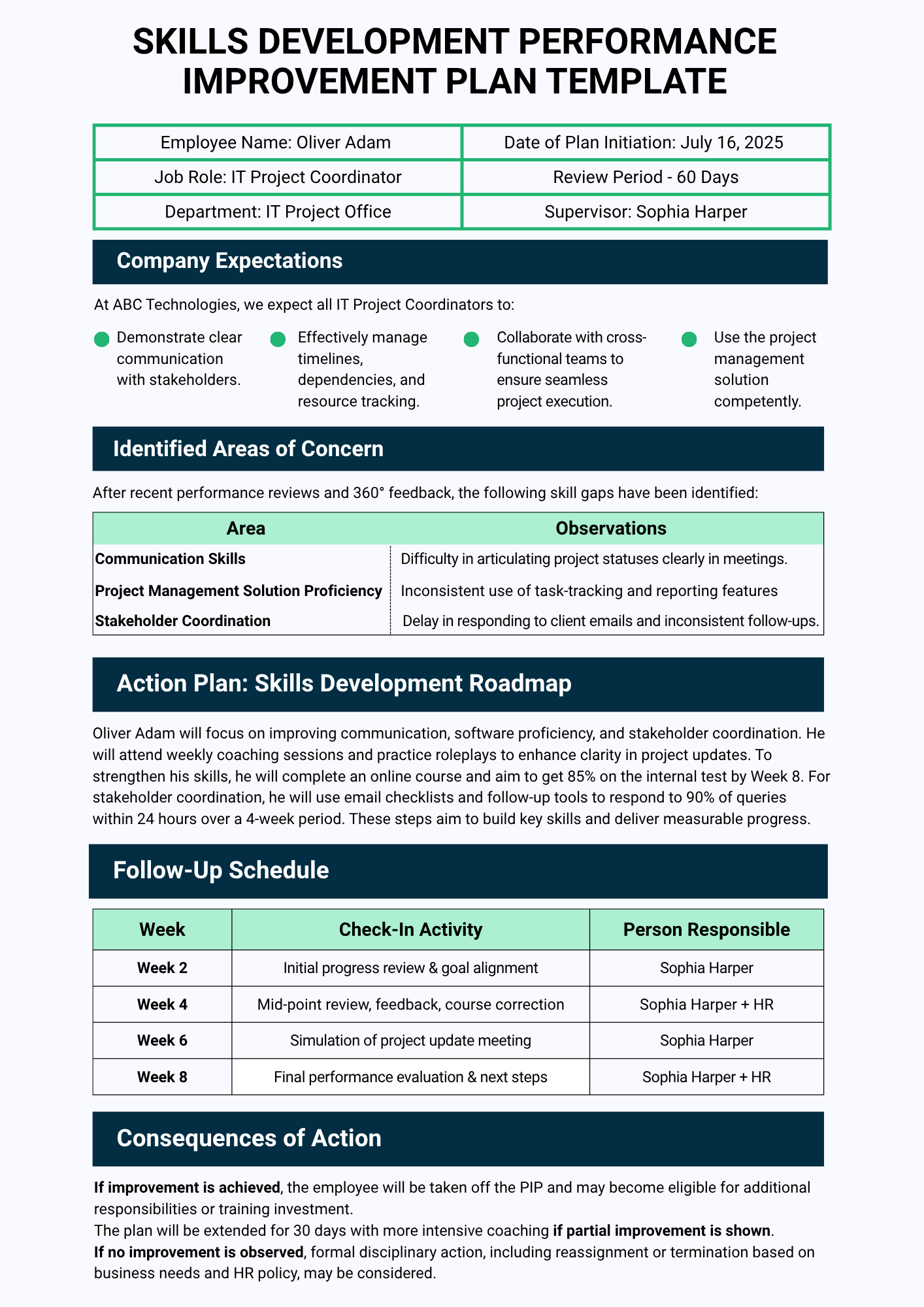
Quick Summary: Underperformance doesn’t just delay projects—it disrupts momentum, erodes trust, and compounds risk. Most project leaders rely on lagging indicators, spotting issues only after the damage is done. A well-crafted Performance Improvement Plan (PIP) changes that—if it’s structured, specific, and timely. This article breaks down what makes a PIP effective: measurable goals, consistent check-ins, root-cause focus, and accountability. But even the best plans fail without visibility. That’s where predictive project management comes in. The solution detects early warning signs and surfaces root causes. It provides real-time performance insights—transforming PIPs from reactive documents into proactive, data-driven recovery tools that safeguard outcomes before timelines slip.
When underperformance goes unchecked in a project environment, the consequences extend far beyond a missed deadline. It damages your credibility, erodes team morale, and jeopardizes project outcomes. The real problem? Underperformance in project settings often goes untracked until the damage is already done—missed milestones, misaligned efforts, and frustrated stakeholders.
Project leaders frequently rely on quick conversations or informal nudges, hoping things will self-correct. However, one contributor falling behind can ripple across timelines, compromise interdependencies, and escalate into full-scale delivery risk. And traditional project status tools? They often surface issues too late—after red flags have already turned into fire drills.
This is where a Performance Improvement Plan (PIP) becomes a project accountability framework. A well-crafted PIP creates structure, sets clear expectations, and restores alignment before a project derails. But it only works if it's implemented with purpose. Vague goals, generic timelines, or inconsistent follow-throughs can do more harm than good, leading to disengagement rather than improvement.
To drive real change, your performance improvement plan must be timely, structured, and supportive. It must be designed not to penalize but to empower contributors to course-correct.
Still, even the most thoughtfully built plan can fall short without real visibility into project performance. That’s where predictive intelligence makes the difference—not by micromanaging individuals, but by identifying systemic issues early, uncovering root causes, and signaling where the real risks lie. It shifts performance management from a reactive exercise to a proactive, data-backed strategy for protecting your project’s health.
In this article, we’ll examine what makes a PIP effective—from establishing measurable goals to fostering a culture of ownership—and how predictive intelligence transforms it into a proactive solution for sustained project performance.
The question isn’t whether performance will dip—it’s whether you’ll catch it before it costs your project.
What Is a Performance Improvement Plan?
A Performance Improvement Plan (PIP) is a structured, high-stakes intervention used to address consistent underperformance in a focused and accountable manner. In project-based work, performance improvement plans are applied when delivery delays, recurring quality issues, or unmet commitments threaten timelines and outcomes. It functions as a formal agreement between the project leader and the team member—defining where performance falls short, what corrective actions are required, and how success will be measured within a defined project delivery window.
A performance improvement plan represents a second chance or a strategic reset. It provides a practical framework of clear objectives, targeted action steps, and consistent oversight to help the project contributor align with the expectations of their role in the project. Whether the challenge stems from missed handoffs, breakdowns in communication, or declining task quality, the PIP creates a structured recovery path with no room for ambiguity.
Before initiating a PIP, project managers must ensure that the team member has had access to proper training, relevant tools, and reasonable support. If performance doesn’t improve, the plan serves as a decisive point of clarity, either a course correction or a transparent, data-backed decision about the next steps. A PIP acts as both roadmap and mirror, outlining accountability checkpoints and clarifying consequences.
However, understanding the structure of a PIP is only part of the equation. Project leaders need insight to drive meaningful improvement in high-pressure project environments.
A performance improvement plan without visibility is a shot in the dark. TrueProject equips project leaders with real-time, predictive performance insights—flagging risk signals early so interventions happen before deliverables go off track. See how we do it.
Why Should You Use a Performance Improvement Plan?
In a project environment, one disengaged contributor, one missed milestone, or one poorly scoped task can cascade into broader delays, cost overruns, and frustrated teams. When left unaddressed, underperformance jeopardizes more than the immediate task; it can derail entire workstreams.
Instead of reacting when the damage is visible, a performance improvement plan gives project leaders a proactive structure to confront performance issues, support struggling team members, and protect project outcomes. Here’s why implementing a PIP in your project delivery framework is critical:
- It clarifies role-specific performance expectations. Vague standards around task ownership, quality thresholds, or deadlines often lead to misalignment. A PIP defines precisely what a successful contribution looks like in the project context, removing ambiguity and reinforcing accountability.
- It documents a performance recovery path. A well-structured performance improvement plan lays out specific, measurable goals tied to project objectives. This shared visibility helps remove subjectivity and keeps project leads, sponsors, and contributors aligned on progress.
- It holds everyone accountable. A performance plan is not one-sided. Project leaders commit to providing clarity, timely feedback, and the resources (including predictive solutions) needed for course correction. Team members are expected to meet defined milestones and improve execution.
- It reduces project disruption and costly turnover. Bringing new team members up to speed mid-project can be disruptive and expensive. A thoughtful performance improvement plan gives current contributors a fair chance to recover performance and re-engage, minimizing the need for replacement and knowledge loss.
- It promotes transparency and trust across the team. Addressing performance concerns head-on signals fairness and clarity. It shows the team that leadership is invested in solving problems—not avoiding them—and that support is available for those willing to improve.
- It preserves team morale and delivery momentum. High-performing teams suffer when underperformance goes unchecked. A performance improvement plan protects their bandwidth and reinforces a results-driven culture where contributions are recognized, and underperformance is constructively addressed.
- It improves visibility into at-risk project KPIs. Missed deliverables, effort slippage, or bottlenecks often stem from patterns of underperformance. With the predictive project management solution, project leaders can track early signals tied to timelines, resource utilization, or quality—empowering them to launch PIPs before minor issues escalate.
Standardizing PIPs through project-ready templates ensures team consistency—nothing gets overlooked, from corrective actions to support timelines and consequences. The real risk? Not having a defined process in place when performance begins to slip.
Recognizing the need for a performance improvement plan is the first step. But to drive real results, you must know how to build one that supports recovery, not just compliance.

Key Elements of an Effective Performance Improvement Plan
Underperformance leads to delivery risk in project environments. An effective performance improvement plan brings structure, visibility, and accountability to course correction efforts. It’s not about going through the motions. It’s about getting contributors back on track—quickly and sustainably. Here’s what separates a perfunctory plan from one that drives meaningful improvement in project delivery:
- Clarity and Specificity: A strong PIP must clearly outline where performance falls short—missed deadlines, incomplete deliverables, or quality concerns—along with measurable goals tied to project outcomes. These goals should follow the SMART framework: specific, measurable, achievable, relevant, and time-bound.
- Resources and Delivery Support: Project team members need access to subject matter experts, project tools, and historical context. Whether it’s documentation, tech support, or targeted mentoring, the PIP should identify what the team member needs to meet delivery expectations.
- Consistent Project Syncs: Regular collaboration between the project lead and the underperforming contributor fosters alignment. These discussions should co-define success criteria and surface blockers and adjust actions based on live project dynamics.
- Ongoing Check-Ins and Feedback Loops: These meetings allow for timely feedback, mid-course corrections, and reinforcement of accountability on both sides.
- Documented Accountability: Every project process step must be captured in writing, from identified issues to agreed-upon action items and consequences. This transparency ensures clarity for the contributor and protection for the project team if escalation becomes necessary.
A well-executed PIP re-establishes trust, restores performance alignment, and protects project outcomes. But even the most well-structured plan can fail without meaningful insights.
Predictive project intelligence gives you the context and data to design targeted improvement plans. TrueProject gives you real-time insights to track progress, detect risks early, and drive real improvement, not just documentation. Book your demo.

Common Missteps to Avoid in Performance Improvement Plans
In the high-velocity world of project delivery, performance improvement plans must be agile, data-driven, and context-aware. When executed well, a PIP can restore alignment and accelerate delivery. But when mishandled, it risks deepening dysfunction, straining team dynamics, and putting project outcomes at greater risk. Most performance plans fail not because the concept is flawed—but because of avoidable implementation errors like these:
- Using Generic Templates That Ignore Context: No two projects are the same. Whether it's differing team structures, tools, delivery timelines, or stakeholder goals, context matters. A generic, one-size-fits-all PIP quickly becomes a checkbox exercise, not a meaningful intervention.
- Treating Surface Symptoms Instead of Root Causes: Missed deadlines or excessive rework are symptoms, not the source. The real issues may be misaligned stakeholder expectations, poor resource allocation, or unclear scope. A high-impact PIP starts with root cause analysis—not just cosmetic fixes.
- Vague Accountability and Blurred Ownership: Ambiguous directives like “improve collaboration” or “work faster” without named owners or concrete timelines are destined to fail. A solid PIP includes specific actions, clear owners, and defined checkpoints.
- Weak or Absent Leadership Support: Performance recovery lacks urgency without buy-in from project leadership or executive sponsors. Contributors need visible backing to clear roadblocks, access resources, and understand that performance expectations are non-negotiable.
- Ignoring Morale and Team Dynamics: Underperformance often results from stress, burnout, or systemic misalignment. A PIP should support—not overwhelm. If morale tanks during the process, performance won’t improve; it’ll deteriorate further.
- Confusing Activity with Progress: More meetings, reports, and dashboards don’t equal impact. If there's no measurable improvement across KPIs like cost, schedule, scope, or quality, effort is misdirected.
- Failing to Build Feedback Loops: Performance plans must evolve. Without frequent check-ins, insight reviews, or mid-course corrections, PIPs quickly lose relevance. Feedback loops keep the plan tied to project realities.
When teams sidestep these common pitfalls, a PIP becomes more than a procedural fix—it becomes a disciplined, strategic tool to protect delivery outcomes. Predictive project management ensures that PIPs don’t rely on lagging indicators but are proactively triggered based on real-time performance deviations.

How Predictive Project Management Solutions Strengthen Performance Improvement Plans
Traditional project oversight often falls short because it's reactive. By the time issues surface—missed deadlines, overspend, defect spikes—the damage is already underway. Predictive project management changes that dynamic. It shifts performance improvement planning from reactive correction to proactive control.
Real-Time Early Warning System
Predictive solutions continuously monitor live project data—task progress, effort burn rate, resource usage, change requests, and stakeholder sentiment. They detect patterns that indicate emerging risk. For example, alerts are generated if the task effort variance crosses a threshold or a stakeholder consistently misses feedback cycles. This gives teams a head start before timelines slip or budgets spike.
Root-Cause Identification, Not Surface Indicators
Instead of treating isolated issues like late deliverables, predictive systems correlate multiple factors: delays tied to specific teams, modules, or workflow stages. These correlations uncover what's causing performance breakdowns. As a result, the performance improvement plan is built on actual data, not assumptions.
Scenario Planning to Test Recovery Actions
The predictive project management solution allows project leaders to simulate the impact of various corrective actions. Want to know how shifting resources affects milestone completion? Or can reducing the sprint scope recover the timeline without hitting quality? These systems can model it before real-world disruption occurs.
Continuous KPI Tracking and Dashboard Reporting
Once a performance improvement plan is in place, the predictive project management solution automates monitoring. They track cost performance index (CPI), schedule variance (SV), change request frequency, and resource allocations, ensuring progress isn’t based on subjective status reports but the real performance indicators.
Stakeholder Communication Becomes Transparent
Instead of manually compiling reports, predictive platforms offer executive dashboards with health trends, recovery progress, and risk forecasts. Stakeholders stay informed, and trust is reinforced through visible, data-backed progress.
AI-Powered Recommendations
The predictive project management solution doesn’t just highlight issues; it suggests corrective actions. Based on past projects and current performance trends, they offer tailored recommendations: reallocate resources, adjust scope, and revisit dependencies. These suggestions accelerate effective recovery planning.
With predictive intelligence embedded in the process, performance improvement plans evolve from reactive patches to systematic early interventions. Instead of waiting for projects to fail, organizations detect risk before it materializes. The result? Fewer escalations, more recoveries, and a measurable impact on delivery performance.
Stop reacting. Start predicting. TrueProject turns performance improvement plans into data-driven action, with real-time alerts, root-cause insights, and AI-backed recovery strategies. No more blind spots. Just results. Discover how it works.

Turn Underperformance into a Strategic Advantage Before It’s Too Late
Project delivery underperformance rarely happens overnight. It builds through misaligned expectations, missed dependencies, and breakdowns in communication. When it finally surfaces, the consequences are costly: stalled milestones, frustrated stakeholders, and declining team morale. When traditional project systems flag the issue, damage has already taken hold.
That’s why performance improvement plans in today’s delivery environments can’t remain reactive or static. They must evolve into strategic, data-informed interventions with structure, foresight, and consistent follow-through. A well-crafted PIP becomes your project’s early warning and recovery system. It’s targeted, supportive, and outcome-focused. But without insight into what’s happening across the team or workstream, even the most carefully designed project plan will fall short because you can’t improve what you can’t see.
This isn’t about micromanagement. It’s about having the clarity, control, and confidence to intervene early—with context, not assumptions. That’s where predictive project management changes the game. With KPI-based tracking, stakeholder sentiment analysis, and delivery risk heatmaps, TrueProject makes every performance improvement plan sharper, brighter, and success-oriented. It empowers project leaders to pinpoint root causes, detect early warning signs, and tailor interventions that reflect what’s happening—not what surfaces after it’s too late.
Your performance plan becomes more than a document—it becomes a living, data-driven framework backed by real-time visibility and continuous monitoring. Don’t wait for missed milestones or team burnout to trigger a response. With TrueProject, your performance improvement plans can stay one step ahead—proactive, predictive, and purpose-built for successful delivery.
You can’t fix what you can’t see. TrueProject gives you real-time risk alerts and data-backed insights to strengthen every performance improvement plan before performance slips further. See how TrueProject strengthens your PIP.






